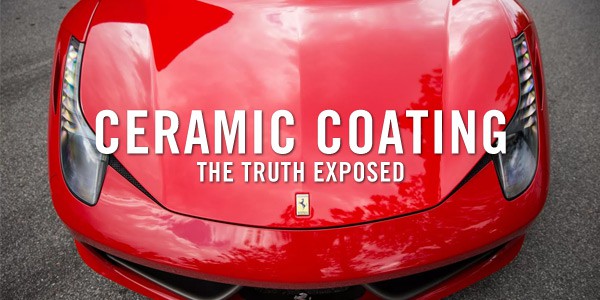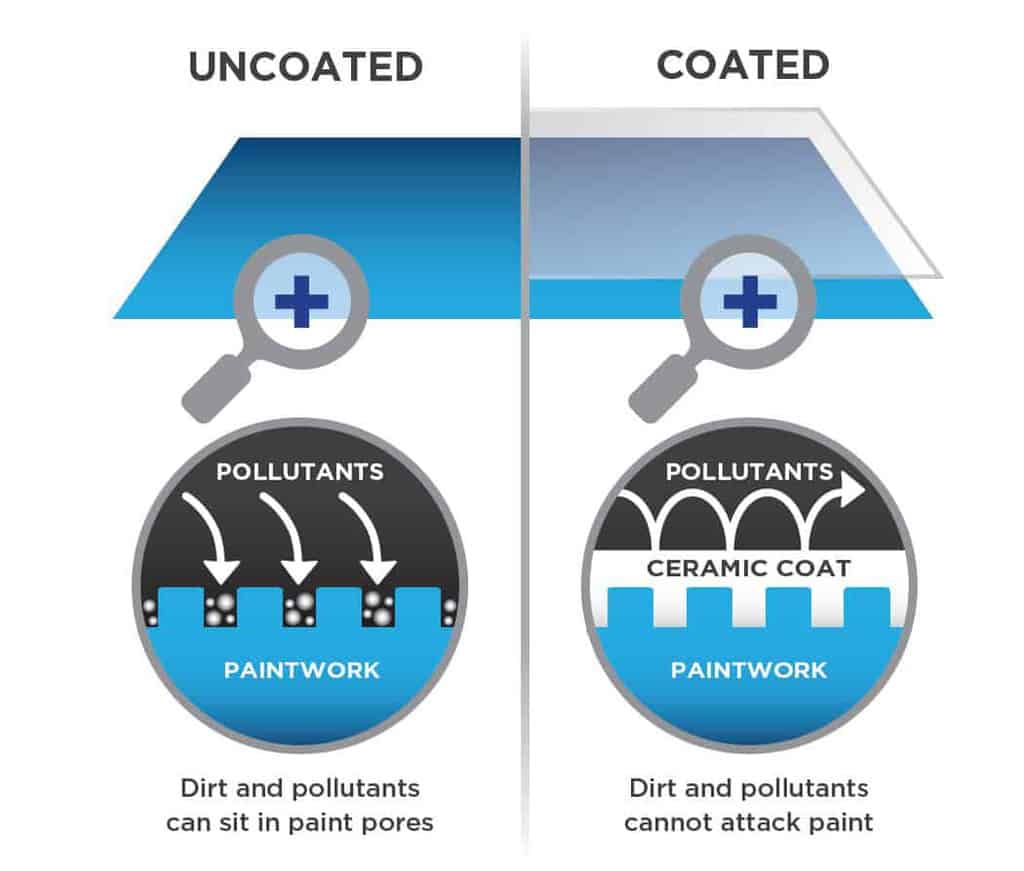The Truth About Ceramic Coating APS - Fairfax August - 2019

Ceramic coating, is the juice worth the squeeze? What is a ceramic car coating in the first place? While there are several ways to spice up the flavor of your daily drivers, such as paint correction or self-cleaning efforts, many consumers are looking into the power of ceramic coating as a viable option.
It’s certainly all over the internet these days with countless videos across social media showing mud being thrown over a hood and sheeting off instantly leaving barely a dirty mark.
For many viewers, this is the first time they’ve even heard of the terms “Ceramic Coating” or “Nano Coating”. Others are skeptical – have the videos been staged in some way? Will the coating ruin my car? And why do they seem so expensive when the bottles are so tiny?
In today’s post, we’re going to look at the realities of ceramic coating your car, whether they do what they claim and help you decide whether it’s for you or not. Although the protection these coatings offer is unrivaled, they do have some potential downsides depending on what you’re after.
Let’s spend some time clearing the facts from the fiction. This is what we’ll be covering today:
BackgroundYou want your car to look as amazing as it did the day you drove it off the dealer’s lot. But despite your efforts maintaining and washing, the scratches, chips, and stains start to spread across your car’s exterior and the paint begins to dull & fade from the sun, which spurns many consumers to find ways of providing UV protection.
Anything and everything is constantly attacking your car’s surface. Mud, dust, dirty rain, water spots, unsightly brake dust, grime start sticking to your car almost immediately after cleaning it. And let’s face it, having to wash your car is boring, monotonous and time-consuming. Snow, ice, salted roads, tree gum, bird shit doesn’t help either.
Automatic car washes scratch and mars your paint, while the chemicals used are terrible for the surface. Not to mention daily life scratches from kids, shopping carts, bikes, and scooters.
Wax adds a good level of shine and gloss, and a small amount of protection, but lasts a few months at best. But it certainly doesn’t act as a quality glass coating product.
Here’s where auto
Ceramic Coatings come in.

A Ferrari getting 9H ceramic coated.
Originally designed for the oil and space industry, the 9h ceramic technology has now expanded quickly into the automotive industry. All because of how effective it really is.
What is a Ceramic Coating for Cars?What is a 9H ceramic coating? The easiest way is to understand Ceramics Coatings are to think of them as a second layer of skin, or a sacrificial layer of protection over your car’s clearcoat.
They utilize nanotechnology, which are essentially tiny particles that form a very fine, thin layer completely invisible to the eye. Because these particles are so small, when applied to a surface, they seal all the pores making the surface hydrophobic (water-repellent), but also resistant to UV, scratches, chemicals, extreme heat and even anti-graffiti. This 9H ceramic layer is completely transparent.

What is a ceramic coating? The difference between an uncoated surface vs. a nano-ceramic coated surface.
The nano ceramic coating forms a semi-permanent bond with a vehicle’s surface, resulting in a ‘sacrificial’ layer that will not wash away under cleaning or rain, or break down over a short period of time. In fact, usually, it lasts years.
They repel dirt and water like nothing else, which makes them easier to clean. Their hardness helps to prevent swirl marks and marring from washing.
What Does a Nano-Ceramic Coating DoThere is a reason why the popularity of ceramic coatings has grown so much. A lot of the benefits are simply unheard of in the automotive industry. There are also some precautions you need to be aware of.
Hydrophobic Is Otherwise known as being very water repellent.
An important feature of a nano Ceramic Coating is that it is hydrophobic. This basically means that water will be repelled instantaneously. When your car is ceramic coated, the incredible hydrophobic effect of the coating will cause water to bead up and roll of the surface along with most dirt, grime, or mud (as it has all been unable to bond to your vehicle’s paint). When people ask “what is ceramic coating” this is often the first demonstration.
Watch the hydrophobic features on the left side of the car, which is coated vs. right side that’s not coated
Any remaining dirt on the car can be removed with less effort. A lot less effort.
Mud & Dirt Repellent Ceramic paint coating works much harder at protecting the surface of your vehicle than an ordinary paint job.
Rain and water bead as opposed to accumulating on the surface. Snow and ice does not stick to the surface. And mud as demonstrated above just slides off.
Protection from UV Damage / Oxidization / Rust Vehicles often exposed to the sun will start seeing the paint fade and look dull. This is caused by the sun’s ultraviolet sun rays, which causes oxidation to the car’s paint. By adding a layer of Ceramic Coating to your paint, you can dramatically reduce the oxidation.
Improved Durability Ceramic coatings or nano coatings, work much harder at protecting the surface of your vehicle than an ordinary paint job. The new coating bonds with the molecular structure of your car’s paint and can’t be dislodged by vibrations or external force, meaning it lasts years not months.
What Does a 9H Ceramic Coating NOT Do?A lot of misconceptions about what the protection does not cover. Even the best ceramic coating does not make your car bulletproof. They’re not some magic all-encompassing product that will solve all potential hazards your surface is exposed to. The truth is not every vehicle will benefit from it.

Even the best ceramic coating doesn’t make your car bulletproof.
They do not stop rock chips, they do not prevent water spots, they do not replace proper care or maintenance, they do not prevent dings or dents, and they do not last forever.
Just because your vehicle has undergone the ceramic paint process or treatment it doesn’t mean you no longer need to dust, wash or remove bird droppings. You still do. The difference is that maintaining your paint will require less elbow grease and less time.
Ceramic Coating MythsMyth 1: Ceramic Car Coatings Are Scratch Proof A lot of detailers and suppliers exaggerate the scratch resistance of 9H Ceramic Coatings for cars, even going so far as to call them scratch-proof or resistant to rock chips which is completely false.
Small scratches can definitely be resisted by a Nano-Ceramic Coating and the sacrificial layer the car coating forms will certainly help against minor incidents that would otherwise mar your surface. For examples, driving through brush, small little knocks from bikes, kids playing, or animals jumping excitedly against the car
Most newer coatings for cars are typically rated 9H on the pencil scale. This is the highest possible scratch resistance, however… 9H Ceramic coatings for cars are not thick or flexible enough to absorb the impact of a rock hitting your paint at highway speed or to resist against someone purposely trying to scratch your car.
Myth 2: Nano Coatings for your Car Don’t Require Maintenance Another myth is that ceramic coated cars do not require washing or maintenance. A coating will heavily cut down on the amount of washing and maintenance but not completely eliminate the need for it.
The fact is if you are going to drive your car, even if it's infrequently, the road is dirty and the surface is going to gradually get dirtier even with a ceramic coat.
It will still require washing, just with a lot less effort and less frequency. Overall with a car coating, it’s going to be much easier.
Myth 3: Car Coatings Are Permanent Partly, this is true. The nano-ceramic coating is actually semi-permanent, as to it bonds with the car surface and cures into a hard and shiny sacrificial layer. That means that you don’t have to re-apply every other month to maintain that glossy surface.
How long does ceramic coating last? With a good product and proper application, it should last at least 2-3 years, however, it is definitely not permanent.
Myth 4: They Are Really Easy to Apply This is actually relatively true. With the new DIY kits becoming available to consumers, the actual application process is relatively easy.
That said, it’s not necessarily simple. Before you can even apply the nano-coating, the surface has to be free of surface blemishes, which applies to even brand new vehicles. The process really depends on the condition of the surface. As the ceramic coating will semi-permanently add a layer over your vehicle’s paint, it’s crucial to do any paint restoration before applying the car coating. It’s up to you to decide, but we do recommend washing the car, claying, buffing, and keeping it pristine while applying the coating.
Myth 5: Ceramic Coatings Provide More Gloss Than Sealants And Waxes Not necessarily. The truth is the nano-coating for cars doesn’t provide the gloss alone – the prep work done underneath is also crucial. If you have faded paint and apply a coating to your car, it will still be faded, with a little bit of shine on top. The same applies for haze or swirl marks, they’ll also be “locked” under the coating if they’re not removed first.
What are the options?Although they’re just now catching wings in the “mainstream” – ceramic car coatings have been around the detailing industry for several years now.
However, because of their prohibitive costs through detailers, they’ve previously only been accessible or cost-effective for enthusiasts or owners of high-end vehicles.
There are two options when deciding you want your auto surface ceramic coated:
Professional Applications DIY Consumer Kits
Professional Application These are (car) ceramic coatings that must be applied by trained and certified professionals and delivers superhydrophobic properties. The use of equipment, experience, and labor makes the cost relatively high, depending on your budget.
The nano ceramic process typically takes anywhere between 1-5 days depending on the condition of your paint, the size of the vehicle and the packages you select.
DIY Consumer Kits Recently, a range of consumer-level car coatings have become available. This has opened up “nano” ceramic coatings to casual drivers who are less concerned about their cars being showroom quality and more about ease of cleaning and protection against the elements.
Specially formulated so that they are much less sensitive than professional-grade car coatings, they are also designed to be applied with little to no experience. The quality durability of these products can vary immensely, but in comparison to the costs of professional applications, they are obviously a lot more accessible to the average driver. A for how to ceramic coat a car yourself, the process is actually quite simple
Conclusion
Hopefully, that helps answer “What is a Ceramic Coating?”.
Is it worth it?
Yes, absolutely, for most cars. The marginal investment, particularly from a DIY standpoint makes a ceramic car coating well worth purchasing. The upfront cost will pay for itself in savings in less than a couple of months. A professional application is also worth exploring if you're not confident that you can do the paint correction on your own.
The important thing is to not expect a magic product that forms a bulletproof force field of protection around your car. What it does do is keep your car looking like its been recently waxed for years, makes dirt fall off super easy, and does a better job of protecting your paint than any wax or sealant.

“Look at this thing, it’s like black glass” –







